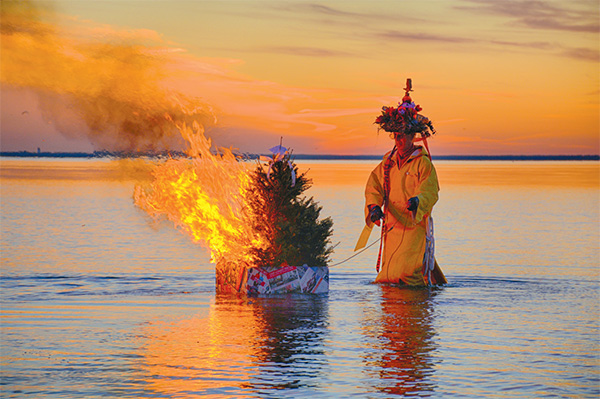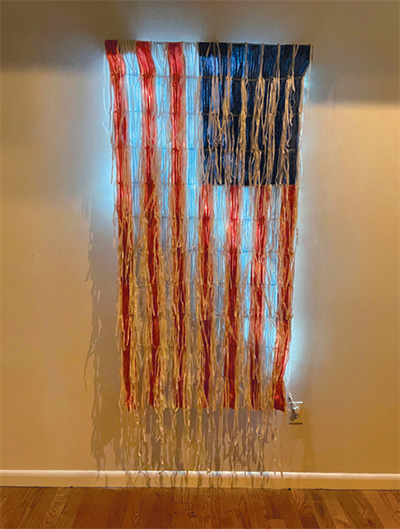Democracy of the Land, Inc., FLAGrancy
Montserrat College of Art, Beverly, MA • montserrat.edu • Through March 5, 2025

Climate activist Jay Critchley, who makes his home in Provincetown, uses the town’s rugged landscape as a source of materials. These include sand, feathers, and Christmas trees upcycled into “re-rooters” for his annual performance staged in the waters of Cape Cod Bay during January. Critchley’s abundant palette also includes recycled plastic shopping bags, architecture and washed-up pink plastic tampon applicators. He regards himself as a conceptual, multidisciplinary and multi-media performance artist and writer. As befits a modern Johnny Appleseed, Critchley has exhibited, lectured and performed internationally as well as nationally.
As though fulfilling a prophecy sparked by catastrophic storms, Critchley had been in conversation with the Montserrat College of Art, in Beverly, MA, about a wide-ranging exhibition focused on patriotism and its symbols, ownership of the “land,” the rights of Indigenous nations and most emphatically, planetary issues now at a tipping point such as the climate crisis and reliance on fossil fuels.
Democracy of the Land, Inc., FLAGrancy also asks us to consider the legal rights of nature, and its connection to the troubling legacy of extracted fossil fuels that produce single-use plastics, including ubiquitous shopping bags polluting oceans, rivers and lakes. Each year, the world produces more than 400 million tons of new plastic: the global abuse of plastics is flagrant.
Critchley arrived on the scene as a “born again artist” in the mid-1980s with his sand car installation Just Visiting for the Weekend, parked at the foot of Provincetown’s MacMillan Wharf. Known for messaging through humor, Critchley’s sand-crusted, rusted, gas-guzzling vehicle attracted wide-ranging attention, including a legal tangle with the town. His attorney prevailed on First Amendment grounds, and the notoriety launched Critchley’s Browncalling as a conceptual artist and environmental activist.

Several decades later, in a Manhattan gallery, Critchley exhibited an iconic MG 1979 sports car mummified with recycled plastic, accentuated by what at first glance appears to be an orange cloud, or smog. Examining the photo-documentation at Montserrat, viewers will note that the “cloud” is fashioned from a field of plastic bags, pinned together so that their openings balloon toward the ceiling.
For Montserrat College, Critchley created imitation snow globes with an ecological twist. Rather than flecks of fake snow, symbols of innocence, Critchley’s sculptural No Snow Globes are filled with motor oil, animals and toys. How much longer, asks the artist, can we ignore the continuing impact of petroleum products on global warming?
Democracy of the Land, Inc., FLAGrancy also highlights Critchley’s ongoing series of modified and fabricated American flag pieces, created in collaboration with fabric artists. There is a 10 x 15 foot American flag, whose surface is tarred and feathered. This statement piece alludes to a horrendous form of “mob justice” with roots in the Middle Ages.
In The Adventures of Tom Sawyer, Mark Twain describes the tarring and feathering of Black persons threatened with lynching. Seen broadly, to include the fate of Indigenous persons forced onto tribal lands and then forcefully evicted, “tar and feathering” remains a symbol of contested lands, and controversies over repatriation. “It is patriotic to honor, celebrate and tend to the land, but whose land?” Critchley asks. “What vision does our flag represent?”
Flagged, a re-imagined American flag from 2005 with blue and white stars on the upper left-hand corner, is made of floor to ceiling strings from surgical masks. It references the 2003 SARS virus.

Critchley is also known for reworking pages from newspapers and magazines to illustrate a contrarian point of view. Starting with a 2003 Newsweek cover titled “SARS,” the acute respiratory disease caused by a coronavirus, illustrated by a mask shielding a woman’s face and titled The New Age of Epidemics, he replaced the initial letter to create “CARS,” a reminder of fossil-fuel pollution wrecking the environment. Critchley also takes to task the publication’s failure to mention the AIDS pandemic, also at its height during the early ‘aughts.
Where Critchley was once thought of as a Cassandra, warning about the dangers of fossil fuels, the range of themes animating his elegant artwork is newly significant for gallery-goers, including art students discovering how to forge a career merged with political activism.
And as we face an era where the artist’s constitutional right to give voice to social and cultural concerns will likely face censorship, Critchley’s visionary, authentic messaging, which employs mediums spanning installation to sculpture and performance, is increasingly urgent. Public programs during the exhibition are planned.
— Susan Rand Brown
